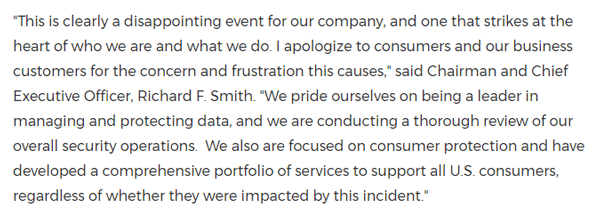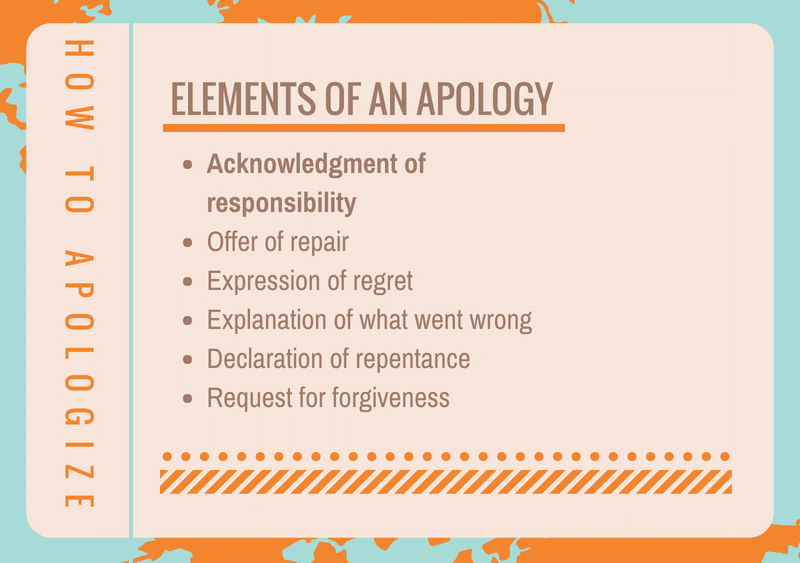Most social media flareups can be resolved one-on-one with a little clarification or some simple resolution. But sometimes in a crisis, a simple response won’t do the job. Sometimes, like it or not, you have to apologize. Whether you’re trying to prevent a crisis or already in one, knowing how to craft a public apology can make all the difference.
Effectively issuing a public apology requires more than just a “We’re sorry.” Unfortunately, corporate apologies have a long history of being underwhelming, and consumers have become skilled at identifying bad apologies. Take this apology from former Equifax CEO, Richard F. Smith, given after it was revealed that the company had leaked sensitive information about millions of consumers:
“A disappointing event,” indeed, though Smith failed to acknowledge how big a problem it might be for the people affected. Commentators also noted that the second half of the statement reads more like an advertisement than an apology.
Equifax had to issue several more apologies in the wake of the incident and is still dealing with its fallout. A more compassionate apology may not have fixed the problem, but it certainly would have left the company in a better light.
Preparing a good apology doesn’t have to be difficult. According to a study from Ohio State University, there are six components of a good apology, ranked from most to least important:
With those elements in mind, here are five steps you can take to create a social media apology or other public apology that works.
5 Things To Include in a Public Apology
1. Understand the Issue.
The worst apologies are the ones we make when we don’t really believe we’ve done anything wrong. If there’s an undercurrent of dismissal or resentment in an apology, people will notice — so take a moment to get your head in the right space before you start.
Chances are, there’s at least some legitimacy in the complaint you’re addressing, someone who’s been genuinely hurt and wronged. What happened might not bother you, but it bothers them, or it bothers the people who’ve heard about it. Try to understand their perspective, and let that inform the tone and content of your apology.
2. Acknowledge Responsibility.
First, let’s get this out of the way: Admitting wrongdoing can have legal consequences. If lawsuits are on the table and you’re concerned about fault, you should have a lawyer look over any apology, public or private, before you make it.
Otherwise, be as honest as possible about the incident that prompted the apology. When someone’s been wronged, the main thing they want to know is that the one at fault knows what they did. An apology that doesn’t address the incident won’t be worth much to anyone.
Name the incident:
Directly identifying the reason for the apology is an important part of taking responsibility. It also shows the recipient that you know why you’re apologizing — because your company has caused harm, not because someone is angry about it.
Use active voice:
“In an unfortunate incident, a guest was incorrectly kicked out of the tour,” removes any active intent on your part and makes it seem as though no one was at fault for what happened. On the other hand, “One of our guides incorrectly kicked a guest out of the tour,” accepts the reality of the situation.
Validate those affected:
When you admit that you’ve done something wrong, you also need to acknowledge the way it’s affected people. “We’re sorry if anyone felt offended,” seems like an attempt to minimize and deflect those feelings of offense. “We’re sorry for the offense we caused,” shows that you acknowledge the validity of the impact.
Starbucks had to apologize after two customers were arrested without cause. Here’s the company’s initial apology:
We apologize to the two individuals and our customers for what took place at our Philadelphia store on Thursday. pic.twitter.com/suUsytXHks
— Starbucks Coffee (@Starbucks) April 14, 2018
This apology drew some ire from already-angry customers, in part because it failed to acknowledge the incident itself. Starbucks apologized “for what took place at our Philadelphia store on Thursday,” and was “disappointed this led to an arrest,” without acknowledging its part in the incident.
A full statement was released later, and it went much further to soothe customers’ frustration:
Creating an environment that is both safe and welcoming for everyone is paramount for every store. Regretfully, our practices and training led to a bad outcome—the basis for the call to the Philadelphia police department was wrong. Our store manager never intended for these men to be arrested and this should never have escalated as it did.
It wasn’t perfect, but at least it partially acknowledged the incident and the company and manager’s responsibility.
3. Make Explanations – But Not Excuses
When you apologize, you might reasonably think that you owe the recipient an explanation of how the incident occurred. After all, you wouldn’t want them to think their experience was just how you do business.
Unfortunately, what might seem like a perfectly reasonable explanation to can easily read like an excuse to others. Knowing that discrimination is against your company values doesn’t help someone who’s been discriminated against. Being told that you’d never intentionally let someone be hurt during your activities won’t comfort someone who’s been hurt even so.
The Starbucks apology makes a classic error: focusing on intentions of the person responsible. While it might comfort Starbucks to know that they didn’t hire a manager who was out to get perfectly ordinary customers arrested, it isn’t reassuring to people worried that they might be next. If anything, it makes the act seem random and capricious.
An explanation can be helpful, but excuses only help the person making the apology. If you want to offer reassurance that this incident was a one-time thing, focus on what happens next when apologizing professionally.
4. Offer Real Repair
A private apology might be complete with some offer of restitution — a refund or a future discount, for instance. But a public apology is a different beast. Once the public gets involved, your apology has to do the hard work of offering repair to the whole community.
This is where Starbucks’ apology shines. In the full statement, the company’s CEO promised a face-to-face apology to the men affected, as well as a full investigation to learn what went wrong. He continued,
“We also will further train our partners to better know when police assistance is warranted. Additionally, we will host a company-wide meeting next week to share our learnings, discuss some immediate next steps and underscore our long-standing commitment to treating one another with respect and dignity. “
Though it caused a considerable hit to its reputation, Starbucks followed this up with company-wide sensitivity training. Ultimately, as crisis communications expert Chris Giglio explains to AdWeek, this example of crisis management could be a very good thing for the brand.
“This is very much a critical time for them. But there’s a possibility they could emerge from this stronger,” he said. “Not only puts it back where it was, but makes it more in tune with where the brand is today.”
Of course, promises of future change are only worth as much as the follow through. Not sure you can deliver specific improvements, or entirely prevent a repeat of the incident? Reassure customers you’ll do your best, instead.
5. Learn From Others
Want a masterclass in public apologies? Visit SorryWatch. Though irreverent in tone, SorryWatch takes an educational approach to corporate apologies, identifying mistakes and flaws so we can learn from them.
Public apologies are hard for a lot of reasons. Some, like the risk of accepting legal liability, can’t be avoided. But others, like pride and defensiveness, are avoidable. Learning to avoid them is the key to a genuine apology.
That’s a skill worth mastering while the pressure’s off, because a good apology can leave you better off than when you started — but a bad apology is often worse than none.
Search The Blog
Categories
Most Popular Articles
- 16 Innovative Tourism Business Ideas and Trends for 2025
- Time to Reflect: A Tour Business Review Can Set You Up for a Year of Success
- How Tour Operators Can Protect Themselves Through 2023’s Flu Season
- Get More Bookings With These 9 Tourism Website Essentials
- How to Create a Business Plan for Your Tour or Travel Company









